Data Transfer Analysis: TCP vs UDP for Long-Term Data Transmission
VerifiedAdded on 2020/04/07
|6
|1055
|106
AI Summary
The assignment delves into the distinctions between TCP (Transmission Control Protocol) and UDP (User Datagram Protocol) for transferring large amounts of data over several days. TCP, known for its connection-oriented nature, ensures reliable data transfer through mechanisms like error checking and retransmission. It is suitable when time is not a constraint due to its slower speed compared to UDP. On the other hand, UDP is a connectionless protocol that allows faster data transmission without guaranteeing delivery, making it less reliable but more efficient for applications where packet loss is acceptable. The assignment also covers the advantages and disadvantages of each protocol, such as TCP's standardized communication and unique addressing versus its slower speed and susceptibility to OS vulnerabilities. Conversely, UDP supports broadcast and multicast connections but lacks reliability in data integrity.
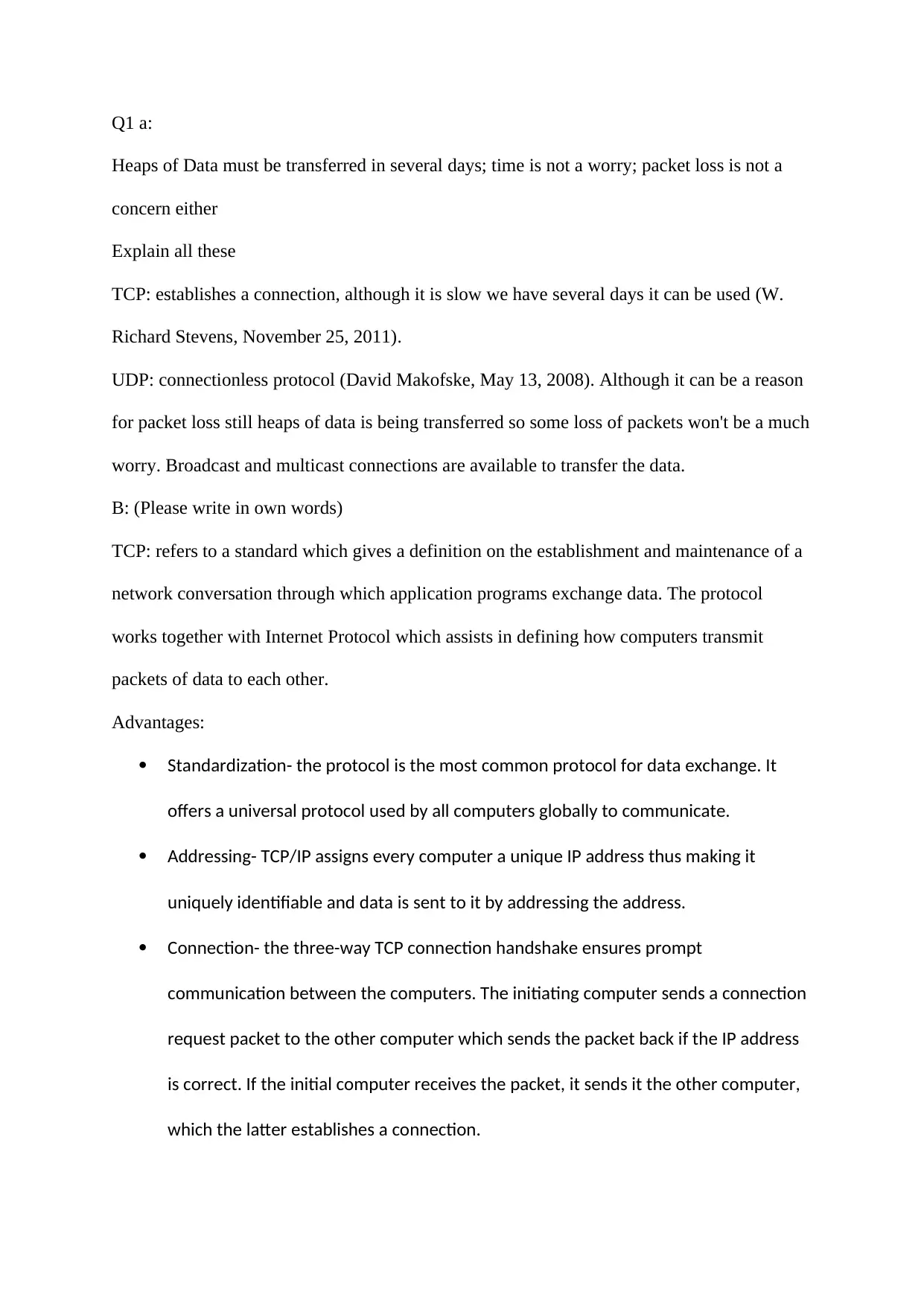
Q1 a:
Heaps of Data must be transferred in several days; time is not a worry; packet loss is not a
concern either
Explain all these
TCP: establishes a connection, although it is slow we have several days it can be used (W.
Richard Stevens, November 25, 2011).
UDP: connectionless protocol (David Makofske, May 13, 2008). Although it can be a reason
for packet loss still heaps of data is being transferred so some loss of packets won't be a much
worry. Broadcast and multicast connections are available to transfer the data.
B: (Please write in own words)
TCP: refers to a standard which gives a definition on the establishment and maintenance of a
network conversation through which application programs exchange data. The protocol
works together with Internet Protocol which assists in defining how computers transmit
packets of data to each other.
Advantages:
Standardization- the protocol is the most common protocol for data exchange. It
offers a universal protocol used by all computers globally to communicate.
Addressing- TCP/IP assigns every computer a unique IP address thus making it
uniquely identifiable and data is sent to it by addressing the address.
Connection- the three-way TCP connection handshake ensures prompt
communication between the computers. The initiating computer sends a connection
request packet to the other computer which sends the packet back if the IP address
is correct. If the initial computer receives the packet, it sends it the other computer,
which the latter establishes a connection.
Heaps of Data must be transferred in several days; time is not a worry; packet loss is not a
concern either
Explain all these
TCP: establishes a connection, although it is slow we have several days it can be used (W.
Richard Stevens, November 25, 2011).
UDP: connectionless protocol (David Makofske, May 13, 2008). Although it can be a reason
for packet loss still heaps of data is being transferred so some loss of packets won't be a much
worry. Broadcast and multicast connections are available to transfer the data.
B: (Please write in own words)
TCP: refers to a standard which gives a definition on the establishment and maintenance of a
network conversation through which application programs exchange data. The protocol
works together with Internet Protocol which assists in defining how computers transmit
packets of data to each other.
Advantages:
Standardization- the protocol is the most common protocol for data exchange. It
offers a universal protocol used by all computers globally to communicate.
Addressing- TCP/IP assigns every computer a unique IP address thus making it
uniquely identifiable and data is sent to it by addressing the address.
Connection- the three-way TCP connection handshake ensures prompt
communication between the computers. The initiating computer sends a connection
request packet to the other computer which sends the packet back if the IP address
is correct. If the initial computer receives the packet, it sends it the other computer,
which the latter establishes a connection.
Paraphrase This Document
Need a fresh take? Get an instant paraphrase of this document with our AI Paraphraser
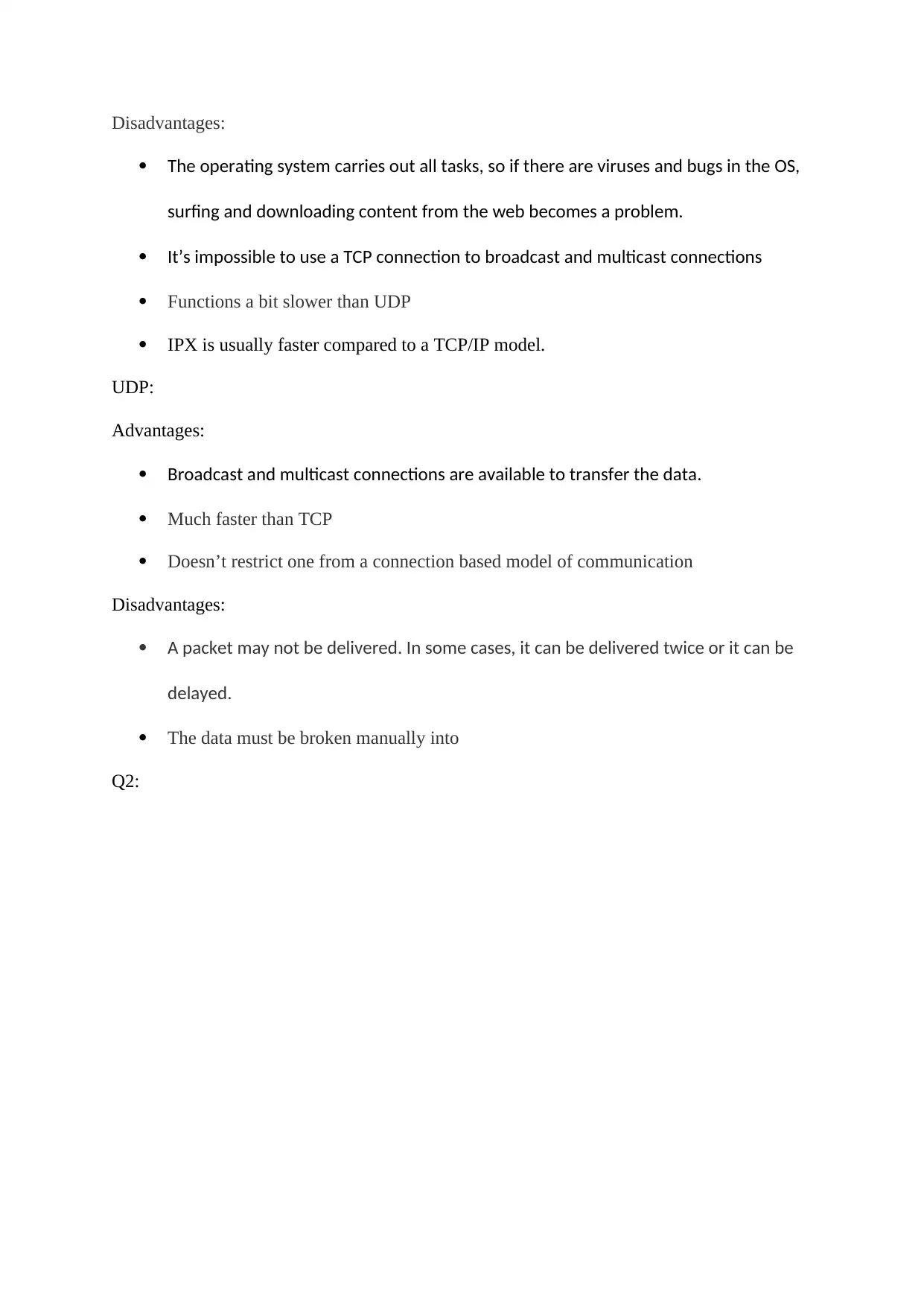
Disadvantages:
The operating system carries out all tasks, so if there are viruses and bugs in the OS,
surfing and downloading content from the web becomes a problem.
It’s impossible to use a TCP connection to broadcast and multicast connections
Functions a bit slower than UDP
IPX is usually faster compared to a TCP/IP model.
UDP:
Advantages:
Broadcast and multicast connections are available to transfer the data.
Much faster than TCP
Doesn’t restrict one from a connection based model of communication
Disadvantages:
A packet may not be delivered. In some cases, it can be delivered twice or it can be
delayed.
The data must be broken manually into
Q2:
The operating system carries out all tasks, so if there are viruses and bugs in the OS,
surfing and downloading content from the web becomes a problem.
It’s impossible to use a TCP connection to broadcast and multicast connections
Functions a bit slower than UDP
IPX is usually faster compared to a TCP/IP model.
UDP:
Advantages:
Broadcast and multicast connections are available to transfer the data.
Much faster than TCP
Doesn’t restrict one from a connection based model of communication
Disadvantages:
A packet may not be delivered. In some cases, it can be delivered twice or it can be
delayed.
The data must be broken manually into
Q2:
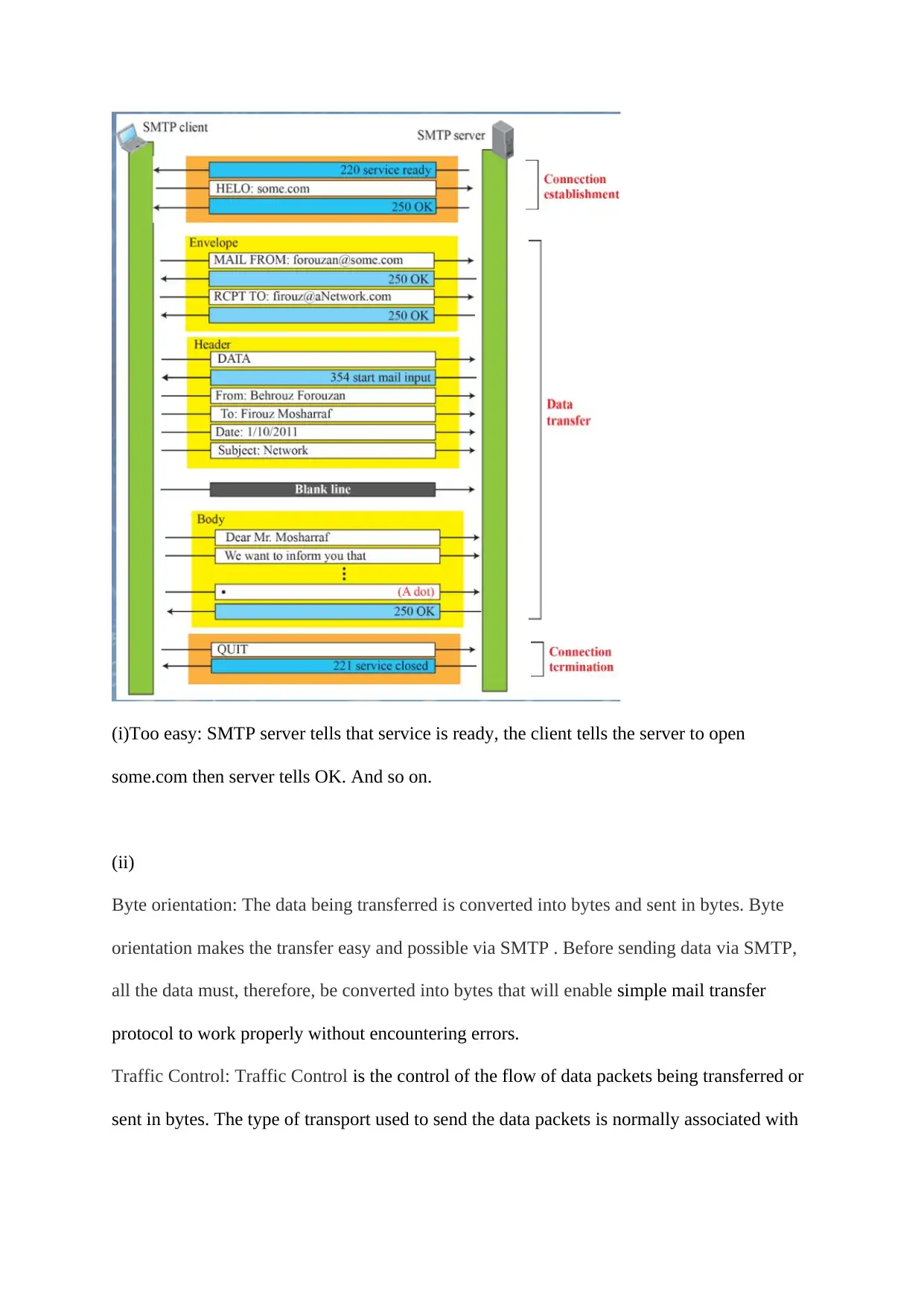
(i)Too easy: SMTP server tells that service is ready, the client tells the server to open
some.com then server tells OK. And so on.
(ii)
Byte orientation: The data being transferred is converted into bytes and sent in bytes. Byte
orientation makes the transfer easy and possible via SMTP . Before sending data via SMTP,
all the data must, therefore, be converted into bytes that will enable simple mail transfer
protocol to work properly without encountering errors.
Traffic Control: Traffic Control is the control of the flow of data packets being transferred or
sent in bytes. The type of transport used to send the data packets is normally associated with
some.com then server tells OK. And so on.
(ii)
Byte orientation: The data being transferred is converted into bytes and sent in bytes. Byte
orientation makes the transfer easy and possible via SMTP . Before sending data via SMTP,
all the data must, therefore, be converted into bytes that will enable simple mail transfer
protocol to work properly without encountering errors.
Traffic Control: Traffic Control is the control of the flow of data packets being transferred or
sent in bytes. The type of transport used to send the data packets is normally associated with
⊘ This is a preview!⊘
Do you want full access?
Subscribe today to unlock all pages.

Trusted by 1+ million students worldwide
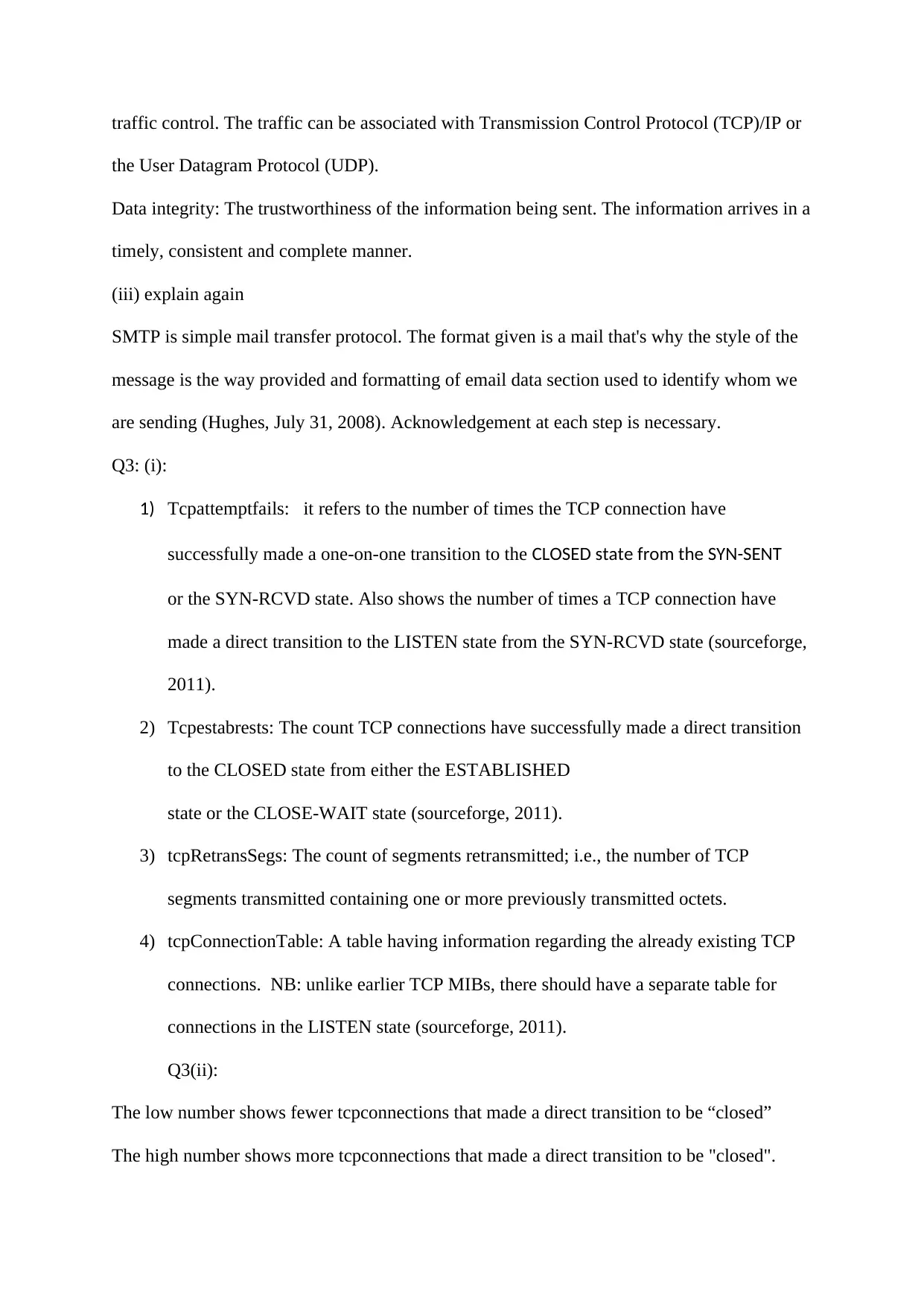
traffic control. The traffic can be associated with Transmission Control Protocol (TCP)/IP or
the User Datagram Protocol (UDP).
Data integrity: The trustworthiness of the information being sent. The information arrives in a
timely, consistent and complete manner.
(iii) explain again
SMTP is simple mail transfer protocol. The format given is a mail that's why the style of the
message is the way provided and formatting of email data section used to identify whom we
are sending (Hughes, July 31, 2008). Acknowledgement at each step is necessary.
Q3: (i):
1) Tcpattemptfails: it refers to the number of times the TCP connection have
successfully made a one-on-one transition to the CLOSED state from the SYN-SENT
or the SYN-RCVD state. Also shows the number of times a TCP connection have
made a direct transition to the LISTEN state from the SYN-RCVD state (sourceforge,
2011).
2) Tcpestabrests: The count TCP connections have successfully made a direct transition
to the CLOSED state from either the ESTABLISHED
state or the CLOSE-WAIT state (sourceforge, 2011).
3) tcpRetransSegs: The count of segments retransmitted; i.e., the number of TCP
segments transmitted containing one or more previously transmitted octets.
4) tcpConnectionTable: A table having information regarding the already existing TCP
connections. NB: unlike earlier TCP MIBs, there should have a separate table for
connections in the LISTEN state (sourceforge, 2011).
Q3(ii):
The low number shows fewer tcpconnections that made a direct transition to be “closed”
The high number shows more tcpconnections that made a direct transition to be "closed".
the User Datagram Protocol (UDP).
Data integrity: The trustworthiness of the information being sent. The information arrives in a
timely, consistent and complete manner.
(iii) explain again
SMTP is simple mail transfer protocol. The format given is a mail that's why the style of the
message is the way provided and formatting of email data section used to identify whom we
are sending (Hughes, July 31, 2008). Acknowledgement at each step is necessary.
Q3: (i):
1) Tcpattemptfails: it refers to the number of times the TCP connection have
successfully made a one-on-one transition to the CLOSED state from the SYN-SENT
or the SYN-RCVD state. Also shows the number of times a TCP connection have
made a direct transition to the LISTEN state from the SYN-RCVD state (sourceforge,
2011).
2) Tcpestabrests: The count TCP connections have successfully made a direct transition
to the CLOSED state from either the ESTABLISHED
state or the CLOSE-WAIT state (sourceforge, 2011).
3) tcpRetransSegs: The count of segments retransmitted; i.e., the number of TCP
segments transmitted containing one or more previously transmitted octets.
4) tcpConnectionTable: A table having information regarding the already existing TCP
connections. NB: unlike earlier TCP MIBs, there should have a separate table for
connections in the LISTEN state (sourceforge, 2011).
Q3(ii):
The low number shows fewer tcpconnections that made a direct transition to be “closed”
The high number shows more tcpconnections that made a direct transition to be "closed".
Paraphrase This Document
Need a fresh take? Get an instant paraphrase of this document with our AI Paraphraser
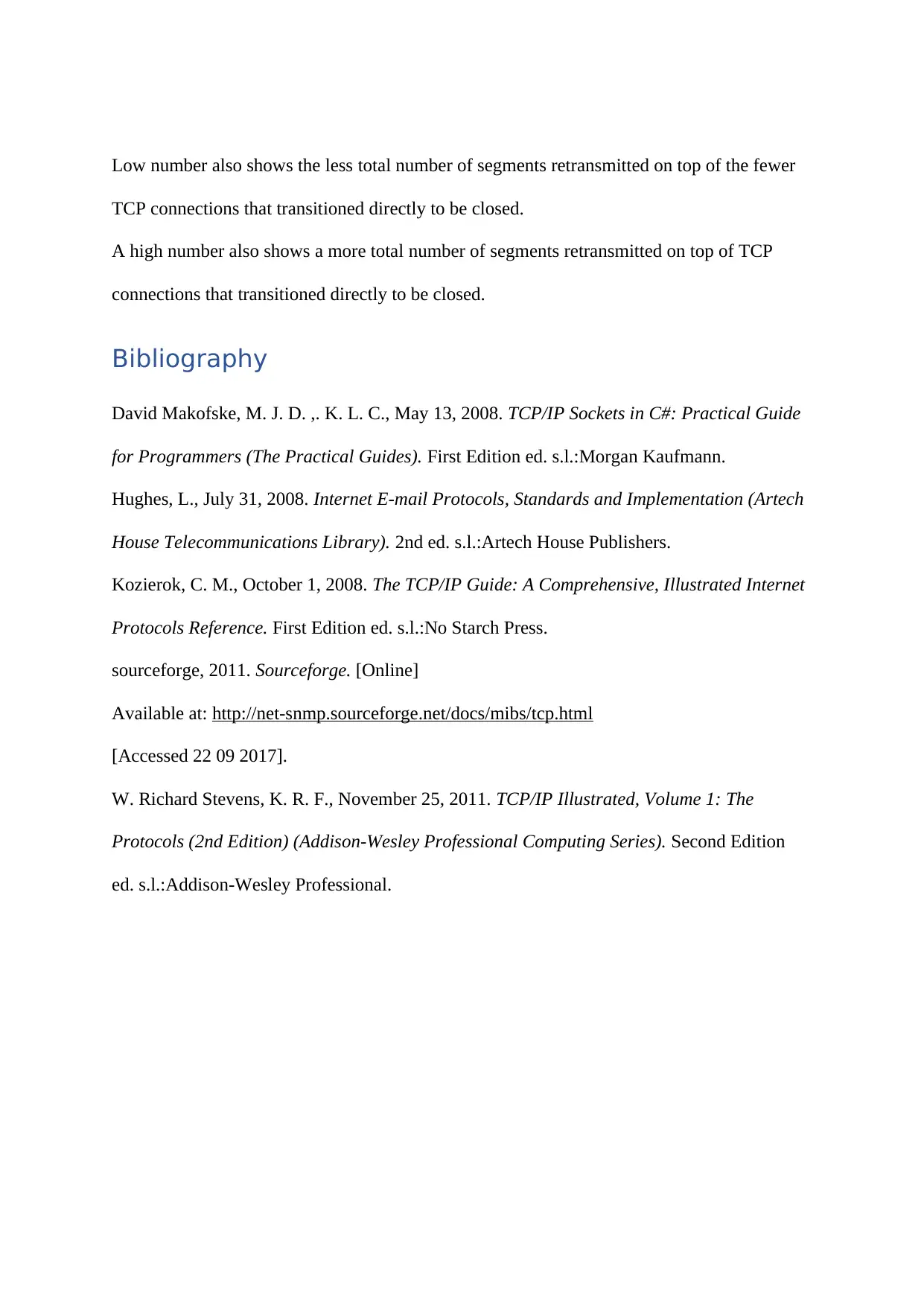
Low number also shows the less total number of segments retransmitted on top of the fewer
TCP connections that transitioned directly to be closed.
A high number also shows a more total number of segments retransmitted on top of TCP
connections that transitioned directly to be closed.
Bibliography
David Makofske, M. J. D. ,. K. L. C., May 13, 2008. TCP/IP Sockets in C#: Practical Guide
for Programmers (The Practical Guides). First Edition ed. s.l.:Morgan Kaufmann.
Hughes, L., July 31, 2008. Internet E-mail Protocols, Standards and Implementation (Artech
House Telecommunications Library). 2nd ed. s.l.:Artech House Publishers.
Kozierok, C. M., October 1, 2008. The TCP/IP Guide: A Comprehensive, Illustrated Internet
Protocols Reference. First Edition ed. s.l.:No Starch Press.
sourceforge, 2011. Sourceforge. [Online]
Available at: http://net-snmp.sourceforge.net/docs/mibs/tcp.html
[Accessed 22 09 2017].
W. Richard Stevens, K. R. F., November 25, 2011. TCP/IP Illustrated, Volume 1: The
Protocols (2nd Edition) (Addison-Wesley Professional Computing Series). Second Edition
ed. s.l.:Addison-Wesley Professional.
TCP connections that transitioned directly to be closed.
A high number also shows a more total number of segments retransmitted on top of TCP
connections that transitioned directly to be closed.
Bibliography
David Makofske, M. J. D. ,. K. L. C., May 13, 2008. TCP/IP Sockets in C#: Practical Guide
for Programmers (The Practical Guides). First Edition ed. s.l.:Morgan Kaufmann.
Hughes, L., July 31, 2008. Internet E-mail Protocols, Standards and Implementation (Artech
House Telecommunications Library). 2nd ed. s.l.:Artech House Publishers.
Kozierok, C. M., October 1, 2008. The TCP/IP Guide: A Comprehensive, Illustrated Internet
Protocols Reference. First Edition ed. s.l.:No Starch Press.
sourceforge, 2011. Sourceforge. [Online]
Available at: http://net-snmp.sourceforge.net/docs/mibs/tcp.html
[Accessed 22 09 2017].
W. Richard Stevens, K. R. F., November 25, 2011. TCP/IP Illustrated, Volume 1: The
Protocols (2nd Edition) (Addison-Wesley Professional Computing Series). Second Edition
ed. s.l.:Addison-Wesley Professional.

⊘ This is a preview!⊘
Do you want full access?
Subscribe today to unlock all pages.

Trusted by 1+ million students worldwide
1 out of 6
Related Documents
Your All-in-One AI-Powered Toolkit for Academic Success.
+13062052269
info@desklib.com
Available 24*7 on WhatsApp / Email
![[object Object]](/_next/static/media/star-bottom.7253800d.svg)
Unlock your academic potential
Copyright © 2020–2025 A2Z Services. All Rights Reserved. Developed and managed by ZUCOL.





